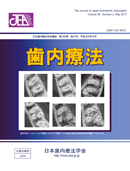Volume 33, Issue 2
Displaying 1-5 of 5 articles from this issue
- |<
- <
- 1
- >
- >|
Review Article
-
2012 Volume 33 Issue 2 Pages 75-86
Published: 2012
Released on J-STAGE: October 31, 2017
Download PDF (3811K)
Original Articles
-
2012 Volume 33 Issue 2 Pages 87-91
Published: 2012
Released on J-STAGE: October 31, 2017
Download PDF (773K) -
2012 Volume 33 Issue 2 Pages 92-98
Published: 2012
Released on J-STAGE: October 31, 2017
Download PDF (3643K) -
2012 Volume 33 Issue 2 Pages 99-104
Published: 2012
Released on J-STAGE: October 31, 2017
Download PDF (1595K) -
2012 Volume 33 Issue 2 Pages 105-112
Published: 2012
Released on J-STAGE: October 31, 2017
Download PDF (1808K)
- |<
- <
- 1
- >
- >|
